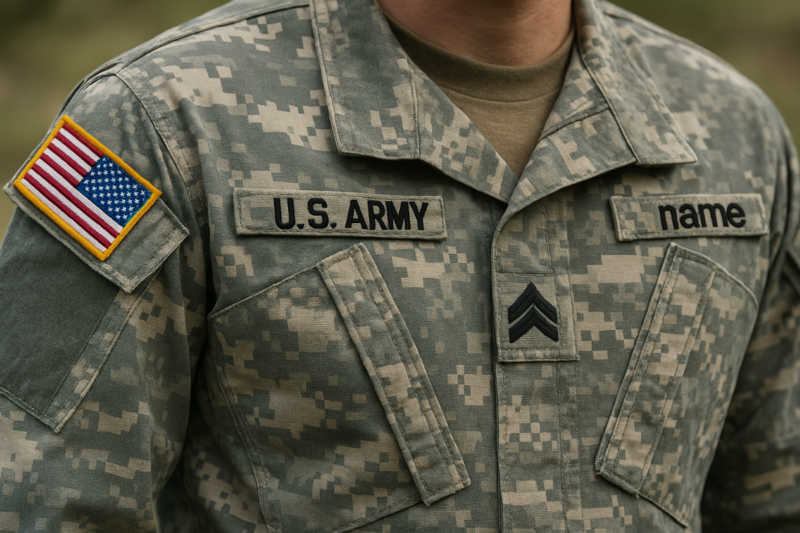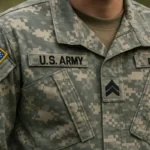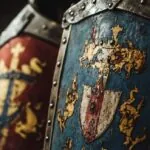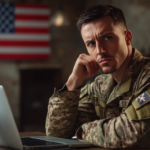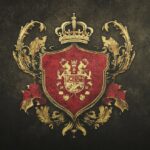Military uniforms follow specific color schemes to serve tactical, symbolic, and psychological purposes. Colors often match the environment where troops operate. Camouflage tones help soldiers blend into forests, deserts, or urban zones. In ceremonial uniforms, colors reflect heritage, rank, and national identity. Every detail on the uniform reinforces the military’s values and functional goals.
Custom patches add a personal and organizational layer to the uniform. MontereyCompany and similar providers create patches that represent units, ranks, missions, or achievements. Uniforms carry more than practical function.
Color, design, and accessories shape perception, support unit cohesion, and display readiness. This article explores why color choices are never random and how tradition and purpose meet in every thread of military attire.
Tactical Advantage
Color plays a central role in battlefield survival. Earth tones such as green, brown, and tan reduce visibility in natural terrain. Enemies cannot easily detect soldiers who wear colors matched to the terrain. This strategy improves mobility and reduces casualties.
Also read How to Include Military Service on Your Resume
Disruption of Human Silhouette
Color patterns do more than blend. They distort outlines. Disruption shapes like blotches or digital squares hide a soldier’s shape. Opponents cannot distinguish human forms at a distance. Combat becomes harder for the enemy.
Examples
Environment
Common Color Scheme
Tactical Purpose
Forest
Olive drab, dark green
Concealment among trees and foliage
Desert
Khaki, light tan
Blends into sand and rock landscapes
Urban
Gray, muted tones
Breaks outline in concrete settings
Arctic
White, pale gray
Matches snow-covered environments
Historical Roots Behind Military Color Schemes
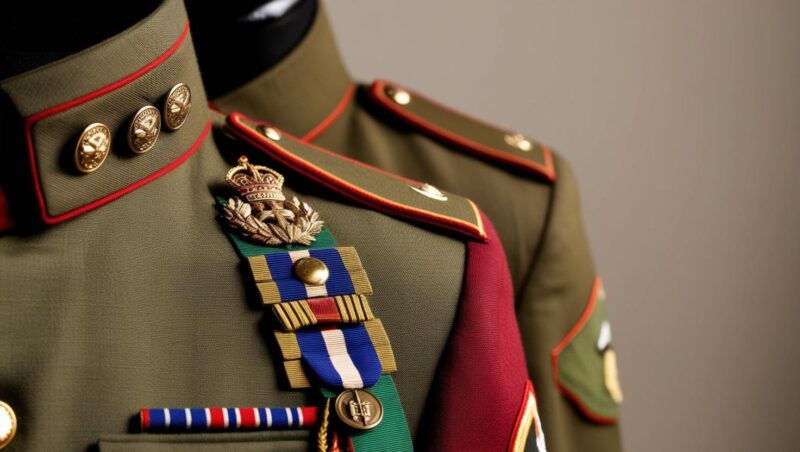
In early warfare, bright red, blue, and white uniforms showed pride, power, and unity. British Redcoats wore scarlet for intimidation and formation control.
Napoleonic Influence
Napoleon’s armies introduced structured, national color codes. French forces wore blue coats with white trousers. This set a standard that spread across Europe. Each uniform reflected national pride, not just function.
Shift in the 20th Century
World War I changed color theory in combat. Mud, trenches, and aerial observation forced armies to abandon bright hues. Olive drab and field gray replaced formal colors. Utility became more important than appearance.
National Identity and Symbolism
Uniform colors signal loyalty to governments or monarchs. American blue, British scarlet, and Soviet green each represent systems of power. Color also supports propaganda and morale.
Ceremonial Uniforms Preserve Heritage
Many armies keep traditional colors in dress uniforms. French gendarmes wear dark blue. Swiss Guards wear Renaissance-style patterns. Each color scheme recalls historical victories and national milestones.
Custom Patches and Flags as Identity Tools
Custom patches enhance national themes. Similar groups provide patches that combine national flags, regimental emblems, or mottoes. Uniforms carry both personal honor and institutional legacy.
Environmental Adaptation: Desert, Jungle, Arctic, and Urban Camo
Sand and rock dominate desert landscapes. Uniforms use light tan, beige, or flat earth colors. Patterns often include microtextures to reduce shine.
Common Desert Color Features
- Light brown base
- Pale gray or tan overlays
- Non-reflective fibers
Jungle Terrain Demands Deep Green Shades
Thick vegetation hides movement but also traps heat. Jungle uniforms combine dark green, brown, and black. Patterns remain bold to counter dense foliage.
Adaptations in Jungle Uniforms
- Moisture-resistant material
- Mold protection treatment
- Darker tones for deeper cover
Arctic Combat Require Visual Blending
Snow and ice reflect light. Arctic uniforms use pure white or ice gray. Designs aim to absorb less heat and prevent visibility in snow-covered areas.
Features of Arctic Uniforms
- White or light-gray outer layer
- Cold insulation
- Anti-glare surface
Urban Zones Bring Unique Challenges
Buildings, asphalt, and artificial light require neutral tones. Urban camo avoids bright contrast. Grays, dusty greens, and charcoal black dominate.
Urban Uniform Highlights
- Noise-reducing fabric
- Modular design for movement
- Gray-scale camouflage patterns
Ceremonial Colors
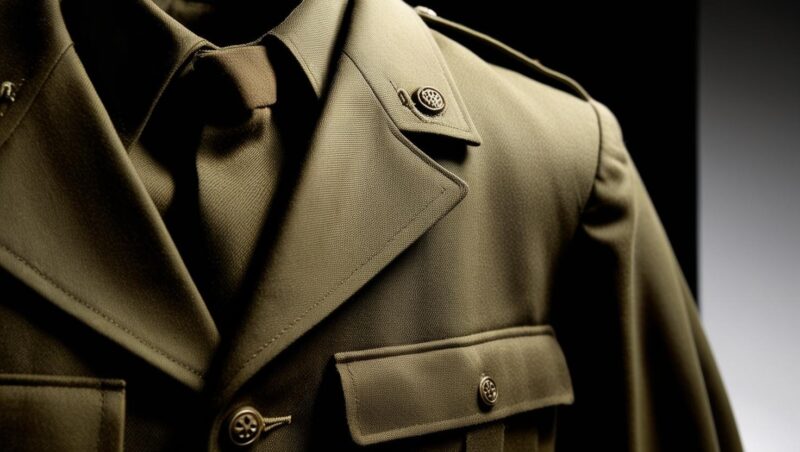
Colors stay bright to honor tradition, mark formal ranks, or represent historical units.
Elements Common in Ceremonial Wear
- Shiny buttons
- Braided cords
- Polished boots
- Medal mounts
Color Shows Status and Formality
Different colors apply to varying occasions. White often marks peace or diplomacy. Black can mark mourning or elite units. Gold accents indicate high rank.
Occasion Type
Uniform Color Examples
Symbolism
Parades
Navy blue, red, gold
Unity, ceremony, national pride
State Funerals
Black, dark navy
Solemn respect
Guard Duty
Blue, silver, scarlet
Tradition and elite service
Branch-Specific Colors and Their Meanings
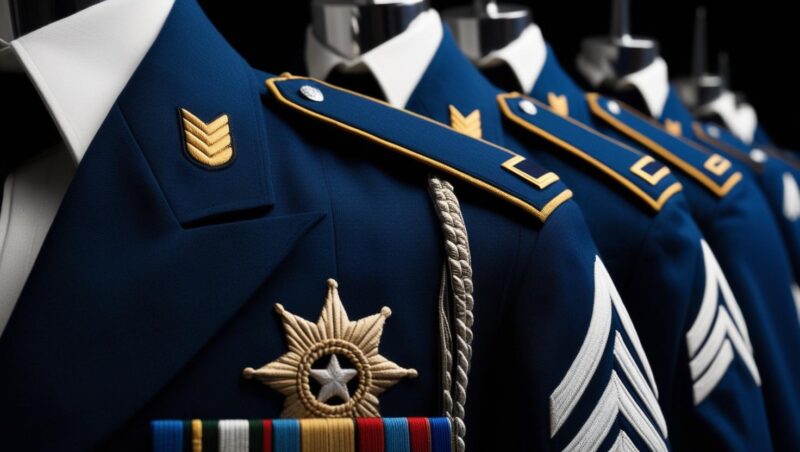
Branch Color Associations in the United States
- Army: Olive drab, Army green
- Navy: Navy blue, white
- Air Force: Slate blue, steel gray
- Marine Corps: Forest green, dress blues with red trim
Color Tells Role Without Words
Service members can be identified by uniform alone. Patches and color combinations reflect specific responsibilities and rank.
Visual Differences by Role
- Pilots: Flight suits in sage green
- Medics: Red or white crosses on armbands
- Engineers: Often use tan with reinforced fabrics
Regulations and Standardization Across Nations
NATO and Allied Agreements
Many countries follow NATO uniform codes. This ensures harmony during joint missions. Standardized color usage allows for coordination and equipment sharing.
- Camouflage tone
- Helmet design
- Patches and insignia placement
- Combat boots style
National Regulation Bodies
Each country uses military branches or defense departments to enforce uniform codes. Changes require testing, approval, and budget allocation.
Examples
- United States: Army Combat Uniform Board
- United Kingdom: Ministry of Defence Pattern Office
- Germany: Bundeswehr Logistics Department
FAQs
Why do military uniforms avoid bright white in non-arctic combat zones?
Bright white reflects light and draws attention. It creates high contrast against most backgrounds. Enemies can easily detect it. White uniforms work only in snow-covered terrain.
Do submariners wear different uniform colors than surface navy crews?
Yes. Submarine crews often wear darker, flame-resistant uniforms. Navy blue or charcoal gray helps mask stains in tight spaces. These materials also offer better fire safety in pressurized environments.
Are military cadet uniforms color-coded by rank or school?
Military academies use specific color schemes to separate cadet classes. For example, first-year cadets might wear different shoulder cords or hat bands. Each academy follows its own rules, often based on tradition.
Can special forces choose their own uniform colors for covert missions?
Special units may receive mission-specific gear with customized patterns. They do not choose colors freely, but their equipment allows more flexibility than standard infantry. Night missions might use all-black kits. Coastal units might use wet-gray tones.
The Bottom Line
Color choices in military uniforms serve clear and strategic purposes. They support survival, signal rank, represent heritage, and shape perception. Every shade, patch, and fabric choice reflects planning, identity, and purpose. Uniforms do not follow fashion. They follow duty, terrain, history, and mission. Color remains one of the most powerful silent tools in military strength.

